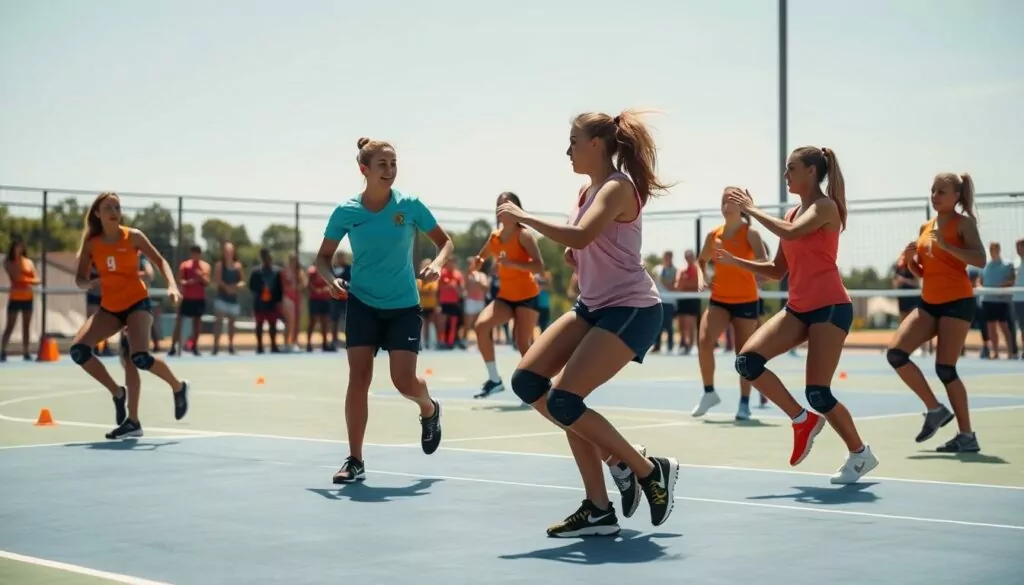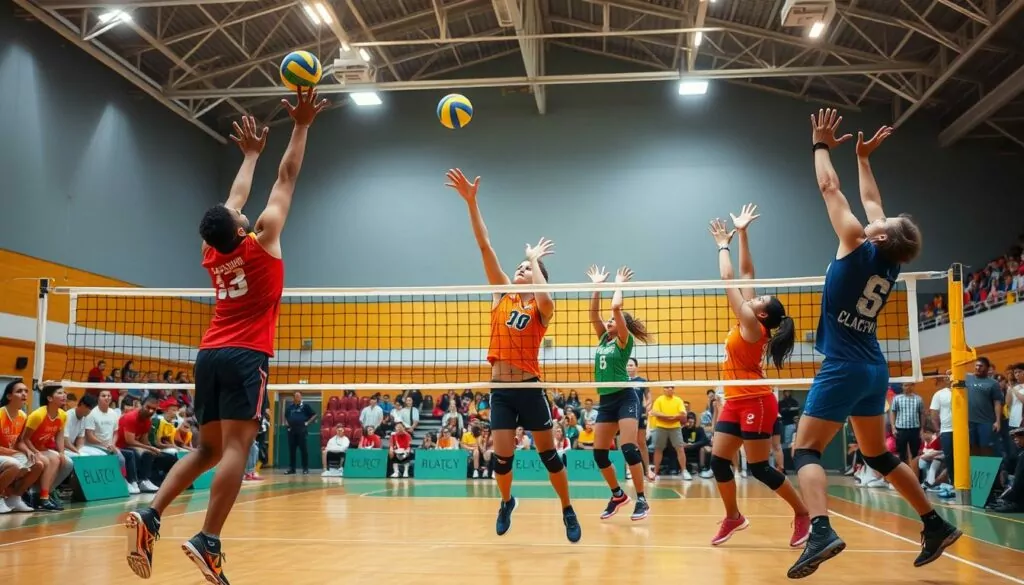I’ll never forget when I learned how vital blocking is in volleyball. Our team struggled against powerful hitters until our coach stepped in. He taught us that blocking is the core of great defense.
This moment changed everything for me. I became determined to improve my blocking skills. The results were amazing. We incorporated these top 10 drills into our training routine.
Our blocks became more consistent and precise. Our confidence grew tremendously. These drills helped us dominate on the court.
I’ll share the key aspects of effective volleyball blocking. You’ll also learn a set of drills for quick, lasting results. These techniques will help you stop even the strongest hitters.
Key Takeaways
- Mastering volleyball blocking is crucial for building a strong defensive game
- These top 10 drills can help players quickly improve their blocking technique and timing
- Consistent practice of these drills leads to increased confidence and effectiveness on the court
- Properly understanding the fundamentals of blocking, such as positioning and footwork, is key to success
- Incorporating plyometric exercises can boost explosive power and vertical jump for more dominant blocks
Essential Fundamentals of Volleyball Blocking Drills

Volleyball blocking mastery requires understanding key fundamentals. This section covers effective blocking techniques, including timing, positioning, and footwork. These elements will help you dominate the net.
Understanding Block Timing and Positioning
Blocking success depends on perfect timing. Anticipate the hitter’s approach and be in the right spot. Learn to read the game and recognize cues for effective blocking.
Proper positioning is crucial for blocking. Good footwork and body alignment create explosive jumps and strong blocks. Jump training exercises and footwork positioning drills will build your blocking foundation.
Core Components of Effective Blocking
Blocking involves multiple skills. We’ll explore hand and arm positioning, plus read-and-react techniques. These are the building blocks of dominant blocking.
Communication between blockers is vital. Learn to anticipate the opponent’s offensive plays. Mastering these elements will help you disrupt attacks consistently.
Safety Considerations and Warm-up Routines
Safety and preparation are crucial before blocking drills. Warm-up exercises and stretches prevent injuries and prepare your body for performance.
Learn proper landing techniques and court awareness. These safety measures will boost your confidence during blocking practice.
“Proper preparation and attention to detail are the keys to becoming a formidable blocker in volleyball.”
Advanced Volleyball Blocking Drills for Solo Practice
Mastering blocking skills is vital for volleyball success. Solo blocking exercises can boost your training regimen. These drills will refine your wall blocking technique and enhance solo practice.
Wall Blocking Drills
The wall blocking drill is an effective solo exercise. Stand in front of a wall with feet shoulder-width apart. Hold your hands high, ready to block.
Toss a ball against the wall and practice your blocking form. Focus on timing, hand positioning, and vertical jump. Add variation by moving laterally to simulate game-like situations.
This helps develop quick reaction time and footwork. These skills are essential for effective solo blocking.
Solo Footwork Drills
- Lateral Shuffle Drill: Set up floor markers and practice quick side-to-side shuffles. Maintain a ready blocking position.
- Zig-Zag Drill: Arrange cones in a zig-zag pattern. Sprint through the course, practicing direction changes and explosive jumps.
- Vertical Jump Drill: Improve jump height with exercises like squat jumps or box jumps.
Consistent practice and attention to detail are crucial for perfecting solo blocking skills. These advanced drills will enhance your versatility and effectiveness as a blocker.
Regular training will prepare you to dominate on the volleyball court. Stay committed to improvement and watch your skills soar.
“The key to becoming a great blocker is not only understanding the fundamentals but also constantly challenging yourself with advanced drills. Solo practice will push you to the next level.”
Partner and Team Blocking Exercises

Boosting volleyball blocking skills requires teamwork. Partner drills improve communication and defensive skills. Let’s explore exercises that sharpen partner blocking and enhance setter-reading abilities.
Communication Drills Between Blockers
Clear communication is key for effective blocking. Practice talking and signaling with your partner during drills. Call out hitters, identify set locations, and make quick decisions together.
These exercises build trust and on-court chemistry. They’re vital for creating a strong blocking duo.
Double Block Coordination Training
Double blocks can change the game. Work with a teammate on timing and footwork. Create a solid wall at the net.
Try different double block setups. Practice moving between them quickly. Improve your lateral quickness drills for better double block success.
Reading Setter Techniques
Spotting setter options is crucial for blockers. Watch the setter’s moves and body language with your partner. Practice adjusting your position based on the set.
This awareness will help disrupt the opposing team’s offense. It gives you an edge on the court.
Add these team exercises to your training. They’ll boost your defensive game significantly. Embrace teamwork to become a formidable blocker.
Mastering Lateral Movement and Quick Response Blocking

Lateral movement and quick response are vital for effective volleyball blocking. These skills help blockers cover more court space and stop opposing hitters. Let’s explore some drills to improve these techniques.
Lateral Movement Drills
Lateral movement drills boost a blocker’s speed and efficiency along the net. The “Zig-Zag Shuffle” is a great exercise for this. Players start at one end and shuffle laterally, changing direction at each end.
The “Rapid Reaction Drill” is another useful exercise. Cones are set up on both sides of the net. Blockers must quickly move to the designated cone when signaled.
Improving Reaction Time
Reaction time is crucial for successful blocking. The “Toss and React” drill helps improve this skill. The coach tosses a ball to one side, and the blocker must quickly move and jump.
By using these lateral movement drills and reaction time training, blockers can become more agile and effective. These exercises prepare them for real-game scenarios and sharpen their defensive skills.
“Lateral movement and quick reaction time are the foundation of elite volleyball blocking. Mastering these skills can transform your team’s defensive presence on the court.”
| Drill | Focus | Benefits |
|---|---|---|
| Zig-Zag Shuffle | Lateral movement | Improves quick, controlled movements and shoulder positioning |
| Rapid Reaction Drill | Reaction time | Develops split-second decision-making and reflexes |
| Toss and React | Anticipation and response | Simulates game-like scenarios and trains blockers to read offensive plays |
Incorporating Plyometrics for Explosive Blocking Power
Boosting your blocking power is key to ruling the net in volleyball. Plyometric exercises can help you achieve this goal. These jump training drills build explosive strength and quick reactions.
Plyometric workouts enhance your vertical jump, agility, and overall athleticism. They push your muscles to exert maximum force quickly. This trains your body to react fast and create explosive movements.
- Squat jumps: Start in a squat position, then explosively jump up, extending your legs and reaching for the sky. Land softly and repeat.
- Box jumps: Stand in front of a plyometric box or sturdy platform, then jump up onto the box, focusing on a powerful takeoff and landing.
- Lateral bounds: Jump side to side, pushing off powerfully with each leg to develop lateral quickness and stability.
Adding these jump training exercises to your routine can greatly improve your defensive blocking techniques. You’ll boost your vertical leap and develop faster reactions. Your timing at the net will also become more precise.
| Exercise | Benefits | Reps/Sets |
|---|---|---|
| Squat Jumps | Increases Vertical Jump, Leg Power | 3 sets of 10 reps |
| Box Jumps | Improves Explosive Power, Plyometric Ability | 2 sets of 8 reps |
| Lateral Bounds | Enhances Lateral Quickness, Agility | 3 sets of 6 reps per side |
Investing time in plyometric training will boost your performance on the court. You’ll become a more dynamic and powerful blocker. Focus on this key part of your volleyball growth.
Stick with these exercises and watch your blocking skills reach new heights. Your improved abilities will make a big difference in your game.
Mental Preparation and Visualization Techniques for Blockers
Mental preparation and visualization are crucial for volleyball blockers. These tools can boost reaction time and improve footwork positioning. Players can become more effective at the net by using their minds.
Anticipating opponent attacks is vital for mental preparation. Blockers can use visualization to simulate game scenarios. This helps them read setter movements and predict hitter actions.
Improved awareness allows for quicker reactions and precise positioning. Players can sharpen their skills through regular mental practice.
- Visualize the court, the opposing players, and the flow of the rally.
- Imagine yourself reading the setter’s cues and reacting accordingly.
- Practice visualizing different attack patterns and rehearsing your blocking footwork.
Staying focused during high-pressure moments is key for blockers. Deep breathing and positive self-talk can help players remain calm. These techniques are valuable in intense competitions.
“The mind is the most powerful tool in volleyball. Mastering visualization and mental toughness can take your blocking to new heights.”
Mental training enhances overall preparation for blockers. It deepens game understanding and sharpens anticipation skills. This approach allows for more precise and confident physical drills.
Combining mental and physical training is essential. It’s the path to becoming a dominant force at the net.
Conclusion
Practicing these volleyball blocking drills can greatly improve your defensive gameplay. They cover essential techniques from block timing to quick response. These Top 10 drills offer a roadmap to boost your blocking skills.
These drills benefit both experienced players and newcomers. Regular practice develops physical skills for powerful blocking. It also builds mental preparation and visualization techniques crucial for on-court success.
Dedication to consistent practice is key to becoming a dominant blocker. Integrate these drills into your training to refine your defensive techniques. Stay committed and watch your volleyball blocking abilities soar.


